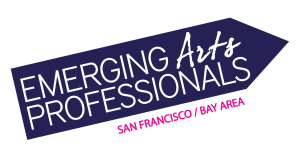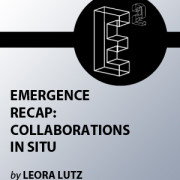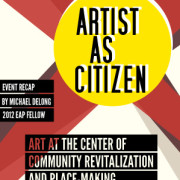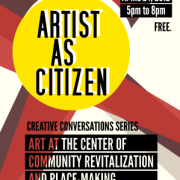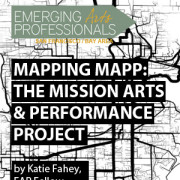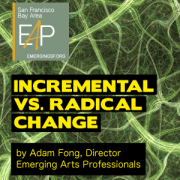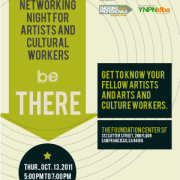Emergence Recap: Collaborations in Situ
Talk is, in fact, not “cheap” as they say: it gets ideas going. When the mission statement loses its voice that is the time to start walking again – to walk the walk. And that is what the three panelists at the Collaborations in Situ discussion at the Emergence Conference on June 4, 2012, have been doing.
At the round table were Renee Baldocchi, Curator of the de Young Museum’s Artist Fellows Program; Lex Leifheit of SOMArts; and Ernesto Sopprani of The *OFFCENTER. Moderated by Julie Potter, EAP Fellow, the panel casually yet passionately discussed the objectives, achievements, and challenges of creating and sustaining a residency program in the City.
Urban residencies stimulate collaboration
Stepping outside of the comfort zone and taking risk became a starting point that each speaker mentioned when reviewing their various program models. New thinking is the key to a residency, from a curatorial standpoint as well as for the artist who will be the resident. Symbiotic to the process of collaboration is creating innovative, engaging, and important experiences for not only the artists but for the public, too.
One particular model of an artist residency is the retreat, or the intensive workshop. Many of them are pastoral retreats, where the artist resides on site in the company of others of like-mind. The residencies range from one month to longer, and are designed for the artists to make work without the distractions of daily life that would normally take away from their studio practices.The residencies in discussion on this day are not pastoral retreats. They are in the heart of San Francisco, and are geared toward not only an extended period of time for intensive art making, but also involve a commitment to engage with the pubic in compelling and innovative ways. All three of the programs support interdisciplinary models of making, incorporating social practice, performance, and exhibitions.
In a sense, the residency helps propel the artist from the solitary position as maker and into the active role of engagement with audiences in innovative ways. The innovation is two-fold as the projects grow between the curators and the resident artists, but also often becomes multifold depending on the additional artists or collaborators that the artist may invite to join them and expand their ideas.
Taking it beyond
A key to innovation with all three of the panelists’ programming is the balance between experimentation and developing a final outcome through rigorous (and fun) exploration and incubation of new ideas. Activating space is part of the final outcome goal in order to impart cultural learning, and to question the role of institutions and their “obligation” to the public.
Through a reciprocal sharing platform, the programs can become sustainable, and be resilient engines for taking risk and being spontaneous. The artist is the centralized idea-generator and the institution or organization works closely with them to develop their concept and bring it to full fruition for the public. Because of the interdisciplinary structure of the work, and the malleability of performative works, the projects can travel – decentralizing the static position of the institution. It gives flexibility to literally drop the art at any location, even exploring new modes of exhibition through the internet, and thus removing the preciousness of site-specificity.
As the round-table continued, new topics came up as the discussion morphed into its own version of a professional performance. One of these nuggets of collective genius brainstorming was the topic of a “Road Map” for artists. In asking themselves out-loud, one has to wonder about the countless other artists that are not being represented or being accepted into their programming. There is not enough funding to include every artist, so how could they help the ones who are left out? The passion and concern to do more is there…what exactly that is will have to happen over more discussions.
Collaboration in situ: it’s meta!
An ongoing challenge of the programs was to address traditional definitions head-on and find solutions every time the word “no” comes up from partnering or governing entities. Reaching out and constantly bringing new people into the mix allows for fresh voices and new perspectives to achieving goals. This drive also creates a dynamic ripple effect throughout the community. It is a continuous learning process – one that requires constant reassessment, revisiting, changing and adjusting with each passing year as the economy changes, and as the artists’ desires change, and the wants of the public changes.
Keeping artists in the forefront of the creative environment and supporting them is the basis for keeping change fluid and vital. Collaborations are an exciting, rewarding business and social model that empowers everyone involved and ultimately extends passion and vitality to the public and the greater community – it is win/win. Seek out mentors, get hands-on, dig in and don’t wait for funding to get started – find a way to do it, and most importantly talk to others.
About Leora Lutz
Leora Lutz is an interdisciplinary artist with an extensive history as a curator, gallerist, and art administrator. Her practice in all aspects grabs onto historical context, alters it, and re-presents it as a way to shift previous understanding into flux. Her work has shown at galleries, institutions, and museums, including MOCA, Palm Springs Museum of Art, UCR Sweeney Gallery, Riverside Art Museum, and the Henry Project Space in Seattle. Her art and professional bibliography includes numerous critiques and profiles from The Los Angeles Times, NBC news, White Hot Magazine and LA Weekly to name a few.
Todd Berman’s work can be found at The Art Don’t Stop. Robbie Sweeny’s photography can be found at In Gutters and Stars.
